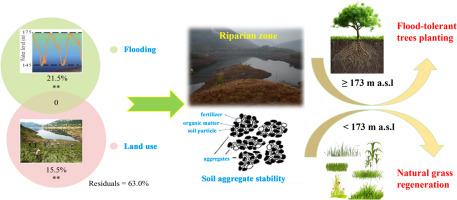Soil and Tillage Research ( IF 6.1 ) Pub Date : 2021-11-19 , DOI: 10.1016/j.still.2021.105263 Kai Zhu 1 , Yiguo Ran 1, 2 , Maohua Ma 1 , Wenjuan Li 1, 2 , Yaseen Mir 1, 2 , Jiaojiao Ran 1 , Shengjun Wu 1 , Ping Huang 1

|
Soil aggregates are considered to be strongly influenced by land use and hydrological regime. Yet, the relative importance of land use and flooding intensity on soil aggregate stability (SAS) in riparian zones remains unclear. Hence, the objective of this study was to examine the effects of land use and flooding intensity on SAS, as well as the aggregate-associated organic carbon (C) and nitrogen (N) contents in the riparian zone along the Three Gorges Reservoir of Yangtze River, China. In 2019, during the reservoir discharge period when the reservoir is at the lowest water level, SAS and aggregate-associated organic C and N contents were investigated along a gradient of the flooding intensity across riparian zones with different restoration practices, including natural grasslands, artificial mixed forests consisting of flood tolerant plants (mulberry and metasequoia), and transplanted lotus. Croplands (i.e., corn, paddy and peanut fields) at different elevations above sea level were used as references. The results showed that artificial mixed forests were more effective in improving the SAS than natural grasslands at elevations above 173 m, while natural grasslands were more effective in improving the SAS than artificial mixed forests and lotus at elevations below 173 m. However, riparian soil stability cannot be simply explained by land use management only, but rather the coupling effects of land uses and flooding intensity. Variation partitioning analysis showed that dam-triggered flooding intensity (21.5%) contributed more than land use (15.5%) in explaining riparian SAS. Also, the soil organic carbon (SOC) and total nitrogen (TN) had significantly positive correlations with the proportion of large macroaggregates (>2 mm) and SAS, indicating that maintaining higher levels of SOC and TN via the development of land use strategies commensurate with the flooding intensity was conducive to the formation and stability of soil aggregates. Meanwhile, the relative contribution of microaggregates (<0.053 mm) to bulk SOC or N content decreased with elevation. Therefore, the finding provides new insights into the focus of C sequestration, and suggests that C assessment should be shifted to microaggregates in the riparian zone. Overall, our study highlights that different land use strategies should be conducted for different elevations to promote SAS, aggregate-associated C and N accumulation in the riparian zone, which can provide a reference for ecological restoration in areas experiencing similar conditions.











































 京公网安备 11010802027423号
京公网安备 11010802027423号